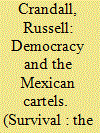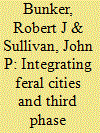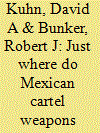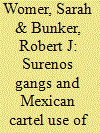|
|
|
Sort Order |
|
|
|
Items / Page
|
|
|
|
|
|
|
| Srl | Item |
| 1 |
ID:
130870


|
|
|
|
|
| Publication |
2014.
|
| Summary/Abstract |
In El Narco, journalist Ioan Grillo provides an overview of the history and dynamics of the Mexican drug war. For years, American and Mexican anti-drug authorities believed that the elusive capo of the Sinaloa Cartel, Joaquín Guzmán, known as 'El Chapo' or 'Shorty', was hiding out in the remote Sierra Madre. But fresh intelligence, apparently gleaned from Guzmán's captured bodyguards, indicated that he had been making clandestine trips to Culiacán, capital of Sinaloa State, and the Northern Pacific resort of Mazatlán. In the early hours of 22 February 2014, ten pickup trucks carrying Mexican marines pulled up at the Mazatlán condominium where Guzmán was believed to be staying. Breaking down its steel-reinforced door, the soldiers found him in bed with his ex-wife, a former beauty queen. Guzmán may have been visiting Mazatlán for only a day or two to see his twin baby daughters, who were also present, before returning to safer confines in the mountains. Although he did tussle with his captors, Guzmán did not attempt to use the machine gun that rested near his bed. No shots were fired in the raid, despite the fact that agents confiscated 97 rifles and machine guns, 36 handguns, two grenade launchers, a rocket launcher and 43 vehicles, many of which were armoured. Having beaten Guzmán and dragged him outside to confirm his identity, the marines transported their prisoner to Mexico City and, finally, a federal detention centre. Shorty had escaped from the high-security Puente Grande Prison in 2001, allegedly in a laundry van, and had been on the run for 13 years. Now that they had him in their hands once more, the Mexican authorities went out of their way to ensure that he would remain in custody.
|
|
|
|
|
|
|
|
|
|
|
|
|
|
|
|
| 2 |
ID:
108344


|
|
|
|
|
| Publication |
2011.
|
| Summary/Abstract |
This essay addresses and integrates 'feral cities' with 'third phase cartel' and 'third generation gangs' (3GEN Gangs) research. The feral cities diagnostic tool will be expanded from three levels (green, yellow, and red) to five (adding purple and black). This will be accomplished by means of the addition of two new levels that model the shift from ferality (de-institutionalization) to criminal re-institutionalization of urban social and political structures around new patterns of living. Such processes set the stage for the projected emergence of the BlackFor (Black Force) within the Americas. BlackFor represents a confederation of illicit non-state actors - essentially a postmodern form of societal cancer - linked together by means of a network of criminalized and criminal (narco) cities as are now arising.
|
|
|
|
|
|
|
|
|
|
|
|
|
|
|
|
| 3 |
ID:
108346


|
|
|
|
|
| Publication |
2011.
|
| Summary/Abstract |
This essay will provide an overview of the major policy positions articulated in the literature pertaining to Mexican cartel weapons origins. The four major positions related to firearms are those of the US Bureau of Alcohol, Tobacco, Firearms and Explosives (BATF), the Mexican government under the Felipe Calderón administration, US interest groups focusing on firearms regulation, and US interest groups focusing on firearms deregulation. The essay will then analyze the major sources of Mexican cartel weapons and then provide conclusions stemming from this analysis and the future trends identified. A component of this assessment will be the provision of gross estimates of the weapons sources themselves in order to show that Mexican cartel weapons origins are diverse in nature and have been increasing in sophistication over time from basic civilian arms into paramilitary and military arms. Part of the reason for this increase in sophistication has been the rise of Los Zetas which has resulted in a deadly 'arms race' taking place between the various Mexican cartels.
|
|
|
|
|
|
|
|
|
|
|
|
|
|
|
|
| 4 |
ID:
093826


|
|
|
|
|
| Publication |
2010.
|
| Summary/Abstract |
Narco use of the Internet, specifically social networking sites by Surenos gang and Mexican cartel members, is a rich yet underexplored area of research in open venues because of its sensitive nature. This essay provides overviews of Surenos gang and Mexican cartel use of the Internet by means of viewing and analyzing primary Internet sources linked to purported narcotics groups and their associates. These patterns of use were then compared to more sophisticated Internet use by terrorist groups with similarities and contrasts noted. This essay concludes with a few general observations concerning likely narco Internet use patterns that will emerge.
|
|
|
|
|
|
|
|
|
|
|
|
|
|
|
|
|
|
|
|
|